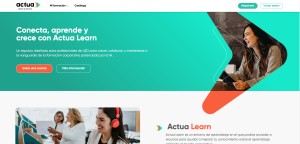Building a learning culture: the key to successful teams

Employee engagement and retention remain significant challenges for many organizations. Despite significant investments in Training and Development (L&D), companies often struggle to keep their employees motivated and inspired to grow within the organization.
The solution lies not in isolated initiatives or standardized training programs, but in building a learning culture that aligns with both business objectives and employee aspirations.
At Actua, we know that the key to developing an engaged and high-performing workforce is to focus on comprehensive learning. This means creating an environment where employees feel supported in their personal and professional growth, where engagement is not an employee-driven action, but the result of consistently implementing the right strategies.
Below, we’ll explore practical steps to help you cultivate a learning culture that drives engagement and supports both business goals and employee development.
Step 1: Align business, talent and learning strategies
Engagement doesn’t happen in isolation; it’s the natural result of a well-aligned work ecosystem. When business objectives, talent strategies and learning initiatives are in sync, you’ll see employee engagement increase.
This alignment starts with understanding your employees’ needs and business objectives. For example, if your goal is to increase internal promotions, your L&D programs should be designed to foster leadership skills development. By aligning learning initiatives with desired outcomes, organizations can ensure that each training initiative has a clear purpose, benefiting both the individual and the organization.
Step 2: Adopt hyper-personalized learning
A recent Gartner study revealed that only 46% of employees are satisfied with their career development.
Today’s employees expect more than just generic training modules; they want customized learning experiences that are tailored to their specific needs and aspirations.
Think of traditional learning as a buffet, offering a wide variety of choices that don’t always meet individual needs. Hyper-personalized learning, on the other hand, is like fine dining, carefully crafted and tailored to each individual.
To make this change, you need to understand your employees’ goals, skill gaps and learning styles. Instead of offering a generic leadership course, provide modular learning paths that are customized for the employee’s current role, future career goals and learning preferences.
Step 3: Motivate coordination between HR and L&D
In many organizations, HR and L&D departments operate independently, creating missed opportunities to collaborate effectively. When HR focuses solely on performance appraisals and L&D delivers training without regard to those appraisals, there is no integrated strategy.
The key is to foster collaboration between the two departments. HR can provide valuable feedback from performance appraisals that will help L&D tailor training programs more effectively, while L&D can ensure that learning outcomes are incorporated into employee development plans.
By working together, you create a unified strategy to promote employee engagement and development, which benefits both the organization and its employees.

Step 4: Understand generational differences
Younger generations see work differently. They care deeply about aligning their values with those of the company, embracing technological innovation and having opportunities for personal growth. Engagement is very personal to them.
It’s crucial to recognize and adapt to the priorities of the different generations on your team. For example, when you ask younger employees about their motivations, they might mention that their alignment with the company’s values is a key factor in joining, and also why they might decide to leave.
Understanding these generational differences enables organizations to offer meaningful development opportunities and foster a culture that reflects the values of today’s diverse workforce.
Step 5: Invest in technology that inspires engagement
The technology that supports your L&D programs is critical to creating an engaging learning experience. engaging learning experience.. If your learning management system (LMS) is outdated or difficult to navigate, employees will not engage, no matter how great the content is.
Investing in modern, intuitive platforms that offer customized dashboards, mobile access and seamless integration with other tools is critical. Technology should enhance the learning experience, making it easier for employees to access materials and allow them to track their progress.
Actua Learnfor example, is a platform designed to help L&D teams stay ahead of the curve by providing the tools and resources necessary for their professional development and growth.

Step 6: Measuring what really matters
Organizations must evolve beyond traditional learning metrics, which tend to focus solely on course completion, and measure the impact of learning on business results. It’s not enough to know how many courses employees complete; what really matters is how those learning outcomes translate into real, measurable business results.
Linking learning to performance, retention and other key business metrics helps demonstrate the true value of L&D initiatives. This data-driven approach can ensure greater investment in future learning programs and show stakeholders the direct correlation between learning and business success.
Conclusion
Building a learning culture is more than delivering training sessions, it’s about creating an environment where employees feel valued, supported and inspired to continually grow. When learning is aligned with business objectives, customized to individual needs and supported by an elearning platform designed for the modern learner, it drives engagement, retention and success.
Did you like this article? Join other L&D professionals in the Actua Learn community to access more resources and participate in discussions about learning and development in the workplace.
Join Actua Learn today and start your journey towards a culture of continuous learning and growth!
Article in collaboration with Totara


